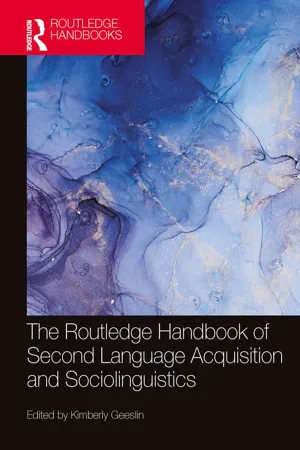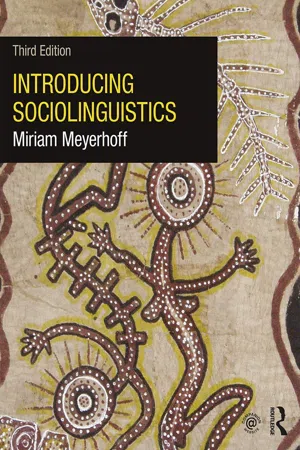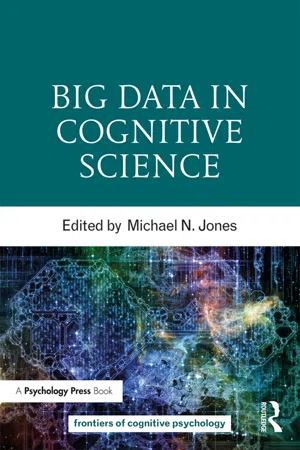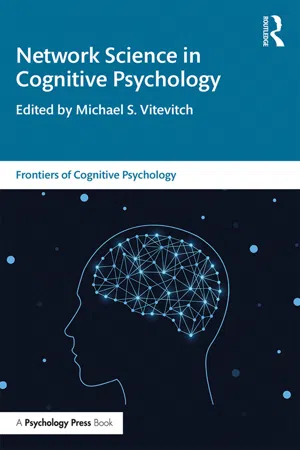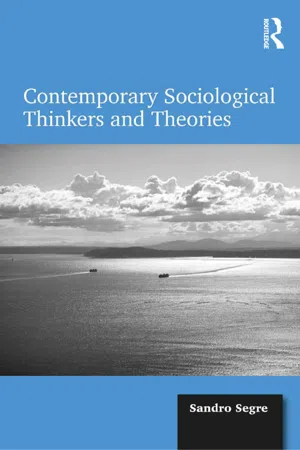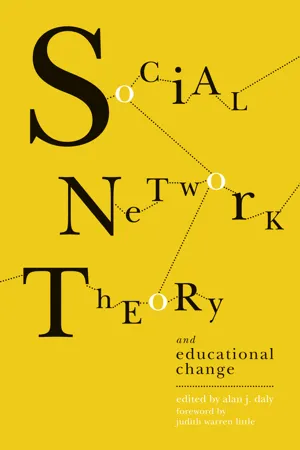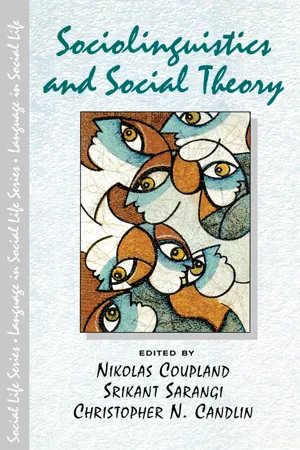Languages & Linguistics
Social Network Theory
Social Network Theory in linguistics refers to the study of how social structures and relationships influence language use and change. It focuses on the connections between individuals and groups and how these connections impact the spread of linguistic features, dialects, and language variation. This theory helps to understand how social interactions shape language patterns and evolution.
Written by Perlego with AI-assistance
Related key terms
10 Key excerpts on "Social Network Theory"
- Kimberly Geeslin(Author)
- 2022(Publication Date)
- Routledge(Publisher)
PART II Sociolinguistic Factors and Their Role in Second Language AcquisitionPassage contains an image
9 SOCIAL NETWORKS
DOI: 10.4324/9781003017325-11Kristen Kennedy TerryIntroduction
In linguistics, social network analysis (SNA) examines the relationships that an individual speaker creates and maintains with others in order to understand, explain, and predict language behavior. SNA has been especially influential in the study of language variation as it relates to the maintenance of non-standard, indexical language features, and it also provides one possible explanation for the diffusion of language change through and across speech communities (J. Milroy & L. Milroy, 1985).As explained by L. Milroy (2002), SNA examines the personal communities - or social networks - that individuals create through their interactions with others, communities that “provide a meaningful framework for solving the problems of daily life” (Mitchell, 1986, p. 74). Milroy further explains that these personal communities may be represented by a social network diagram representing the ties, or relationships, between the individual (ego) and others. The ties that an individual forms with others may be characterized as strong or weak ties; strong ties may be multiplex, dense, or both. Multiplex ties refer to the multiple ways that one individual may be linked to another (e.g., they are neighbors and co-workers). Dense ties are those that link many of the same people to each other, thereby forming a closed circle or network. Conversely, weak ties are neither dense nor multiplex - they refer to the type of uniplex, or singular, relationship that one might have with a local merchant or an acquaintance.SNA has generally focused on first-order ties that are directly linked to the individual, ego, as well as second-order ties that are removed from ego by one person, such as a friend of a friend (L. Milroy & Llamas, 2013). The relationships that link first-order network ties are also differentiated on the following basis; exchange network ties refer to family and close friend relationships that involve regular contact and the exchange of direct aid, advice, and criticism (Milardo, 1988, pp. 26-36). Interactive ties, on the other hand, exist between ego and those with whom he/she has regular contact, but on whom ego does not rely for material or symbolic resources. Thus, exchange networks are normally characterized by strong (multiplex and/or dense) ties and interactive networks by weak ties. Additionally, passive- eBook - ePub
- Miriam Meyerhoff(Author)
- 2018(Publication Date)
- Routledge(Publisher)
6 when we considered the impact of addressee and domain on the way speakers talk.Social networksSocial networks can be defined as ‘the relationships [individuals] contract with others … [reaching] out through social and geographical space linking many individuals’ (Milroy and Gordon 2003: 117). Whereas grouping people into social classes involves compartmentalising them on the basis of factors that may matter to society as a whole (e.g., how prestigious their jobs are), social networks group people on the basis of factors that are more idiosyncratic. Social networks are defined by who your friends are, who your kids are friends with, who you live near, who you have dinner or have drinks with, and who you work with. Network analyses also ask how often the members of all these groups are the same, and how often they are completely different.It is very important for sociolinguists to have a sense of what the patterns of associations are between people who are friends or roughly social equals within a community. This is because the diffusion of linguistic change happens relatively fast and very efficiently along what we might call horizontal channels (e.g., within one age group and a social cohort). What we might call vertical channels (e.g., channels between generations or across big social divides) are a comparatively slow and inefficient means of transmitting innovation. So it is common knowledge that kids talk more like their friends than they do like their parents (and that’s what gives rise to the nice age differences underpinning the apparent time construct discussed in Chapter 7 ).The significance of social networks emerges implicitly in sociolinguistics as early as Labov’s study of Martha’s Vineyard. There, as we saw, the networks of the Chilmark fishermen and the Menemsha Native Americans were characterised (respectively) by higher levels of (ay) and (aw) centralisation than were found in other groups. The Native American community was a relatively self-contained network of individuals because of the regional and cultural isolation of the reservation. The fishing community also formed a reasonably self-contained network. Partly this was because they were located at the end of the island furthest from the growing tourism industry, but their network was also characterised by a more general orientation to traditional Island ways of life. - eBook - ePub
- Patricia Friedrich, Eduardo Diniz de Figueiredo(Authors)
- 2016(Publication Date)
- Routledge(Publisher)
linguistic network that one develops from such ties.Nonetheless, the conception of social network may still be limited (Romaine, 2000) given that its effectiveness and precision in explaining how speech patterns are created and developed depend on how well the idea can be fitted into a more general theory of social behavior and human action. For example, conflicts may exist between an individual’s different types of networks (e.g., one’s family values vs. the values of one’s school/work community), and some networks can be more powerful than others in terms of imposing their norms upon language users. Still, the understanding of social and linguistic networks, and their use in socio-linguistic research, has brought more complexity to the understanding of language use and helped to explain linguistic choices more precisely. Networks can also be thought of as being elastic and of different sizes depending on the number of participants who share linguistic, cultural, and social beliefs and practices.In the Internet era, the concept of social network has gained much force due to at least a few factors. For one, the term “social network” itself has been used widely to describe different websites where users connect to one another in webs of relationships, being able to share their thoughts, images, profiles, and so on with all their contacts, as well as with those to whom their contacts are connected. Note that such connections may actually exist only virtually, as many members of Internet social networks will never get to know each other in “real life.” In addition, the Internet has given us a chance to visually construct our networks. The tools now available allow for the grouping of those we know according to interest, level of acquaintance, profession, and language, all of which are elements that abstractly helped us define our networks before but that might have been invisible to us. - eBook - ePub
- Michael N. Jones(Author)
- 2016(Publication Date)
- Psychology Press(Publisher)
5SOCIAL STRUCTURE RELATES TO LINGUISTIC INFORMATION DENSITYDavid W. Vinson and Rick DaleAbstractSome recent theories of language see it as a complex and highly adaptive system, adjusting to factors at various time scales. For example, at a longer time scale, language may adapt to certain social or demographic variables of a linguistic community. At a shorter time scale, patterns of language use may be adjusted by social structures in real time. Until recently, datasets large enough to test how socio-cultural properties—spanning vast amounts of time and space—influence language change have been difficult to obtain. The emergence of digital computing and storage have brought about an unprecedented ability to collect and classify massive amounts of data. By harnessing the power of Big Data we can explore what socio-cultural properties influence language use. This chapter explores how social-network structures, in general, contribute to differences in language use. We analyzed over one million online business reviews using network analyses and information theory to quantify social connectivity and language use. Results indicate that perhaps a surprising proportion of variance in individual language use can be accounted for by subtle differences in social-network structures, even after fairly aggressive covariates have been added to regression models. The benefits of utilizing Big Data as a tool for testing classic theories in cognitive science and as a method toward guiding future research are discussed.IntroductionLanguage is a complex behavioral repertoire in a cognitively advanced species. The sounds, words, and syntactic patterns of language vary quite widely across human groups, who have developed different linguistic patterns over a long stretch of time and physical separation (Sapir, 1921). Explanations for this variation derive from two very different traditions. In the first, many language scientists have sought to abstract away from this observed variability to discern core characteristics of language, which are universal and perhaps genetically fixed across people (from Chomsky, 1957 to Hauser, Chomsky, & Fitch, 2001). The second tradition sees variability as the mark of an intrinsically adaptive system. For example, Beckner et al. (2009) argue that language should be treated as being responsive to socio-cultural change in real time. Instead of abstracting away apparently superficial variability in languages, this variability may be an echo of pervasive adaptation, from subtle modulation of real-time language use, to substantial linguistic change over longer stretches of time. This second tradition places language in the broader sphere of human behavior and cultural products in a time when environmental constraints have well-known effects on many aspects of human behavior (see Triandis, 1994 for review).1 - eBook - ePub
- Michael S. Vitevitch(Author)
- 2019(Publication Date)
- Routledge(Publisher)
1 THE INFLUENCE OF SOCIAL NETWORK PROPERTIES ON LANGUAGE PROCESSING AND USEShiri Lev-AriLanguage is a social phenomenon. We learn, process, and use it in social contexts. In other words, our social environment shapes our linguistic knowledge and use. To a degree, this is trivial. A child exposed to Japanese will become fluent in Japanese, whereas a child exposed to only Spanish will not understand Japanese but will master the sounds, vocabulary, and grammar of Spanish. It is by tracking the patterns in our environment that we learn language. Therefore, individual differences in our social environment could influence the input we receive and, consequently, what we know about language, how we use it, and how we learn from our input. In this chapter, I will first review briefly past research on the role of statistical learning in language acquisition. Then I will take up the case of individual differences in social network properties. I will show that social network properties influence the distributional properties of our input, and, consequently, the product of our statistical learning from it. I will show that social network properties thus influence our linguistic knowledge, how well we understand other speakers, and how malleable we are to the influence of our interlocutors.Statistical Learning
Language is a structured system. Sounds and words do not occur randomly but are characterized by regularities. Learners are sensitive to these regularities and exploit them when learning language. For example, the sounds of our language are not spread uniformly over the entire sound space but fall into categories, with the sounds of each category forming a normal distribution around its peak. This distributional property provides the learner with valuable information about the number of categories that need to be learned and what they are. After all, languages differ in the distinctions that they make, and so a unimodal versus a bimodal distribution along a certain variable is informative regarding whether the language makes a distinction along this variable. Unsurprisingly, learners are sensitive to the shape of the distribution of their input and use it to infer the number of categories. Thus, infants exposed to a unimodal distribution along the Voice Onset Time (VOT) continuum do not distinguish sounds on the two ends of the distribution, whereas infants exposed to a bimodal distribution do (Maye, Werker & Gerken, 2002). Another way by which statistical learning helps with cracking the linguistic code is by extracting co-occurrence information. When we speak, we do not clearly separate words. This becomes evident when we listen to a language we do not understand. In those cases, we often find it difficult to tell when one word ends and another one begins. Sounds, however, do not appear in a random order but are governed by phonotactic rules and language-specific probabilities. Thus, certain sounds are more likely to follow one another within words than across words. Infants are sensitive to these transitional probabilities and use them to segment words (Saffran, Aslin & Newport, 1996). This sensitivity is important for isolating words and therefore for lexical acquisition. Of course, whole words also do not follow each other in a random order either but follow grammatical constraints. For example, adjectives precede rather than follow nouns in English. Learners are sensitive to these transitional properties as well and can extract them to learn the grammar of a language (Thompson & Newport, 2007). - eBook - ePub
The First Compendium of Social Network Research Focusing on Children and Young Adult
Social Networks of Children, Adolescents, and College Students
- Suzanne Salzinger, John Antrobus, Muriel Hammer(Authors)
- 2015(Publication Date)
- Psychology Press(Publisher)
In their seminal paper assessing the many direct and indirect influences that members of the wider social network can exert on the developing child, Cochran and Brassard (1979) deplored the paucity of studies that had included social networks as a major variable. Although social network studies have received increased attention as researchers have expanded their conception of the child’s social world, most studies have focused on middle childhood (e.g., Bryant, 1985), often in school settings (e.g., Ladd, 1983). Those few studies that have addressed the influence of social networks on preschoolers and infants have attempted to assess the indirect influence of the maternal social network on early development, such as the buffering effect of a supportive network against maternal stress (Crnic, Greenburg, Ragozin, Robinson, & Basham, 1983). Ladd (1984) has exhorted developmental psychologists studying social networks to go beyond merely mapping networks to attempting to relate social networks to important developmental outcomes. The two chapters in this volume focused on language development seek to examine the direct influence of the child’s own social network on the child’s development by examining one of the major transitions of the preschool period.While the role of peer relationships in the emergence of children’s social skills has received attention (see, for example, Eckerman & Stein, 1982; Goldman & Ross, 1978; Mueller & Brenner, 1977) most work on language development has restricted itself, in contrast, to the mother-child dyad, examining dimensions of the mother’s speech in relation to the child’s. Apart from a few studies that have focused on the input of fathers (Giattino & Hogan, 1975; Gleason, 1975; Golinkoff & Ames, 1979), there has been no systematic investigation of the impact of the child’s social environment, that is, the effect of the child’s total social network, on language development. A preliminary study by Salzinger and Hampson (see chapter 2 ) revealed relationships between the composition of the child’s social network and gross features of the child’s emerging language. This chapter describes a follow-up study, which sought to examine the relationship between social network variables and individual differences in language acquisition strategies. In addition, the study attempted to characterize variation in the mothers’ functional use of language that might constrain and influence the children’s developing styles.The study of individual differences in language acquisition is a relatively recent phenomenon. During the 1960s, because of Chomsky’s influence, researchers were attempting to characterize the child’s developing grammar (e.g., Braine, 1963; Brown & Fraser, 1964). The focus of the inquiry was therefore universal features across children, and across languages, and individual differences were of no theoretical significance. Variations in children’s strategies for acquiring language first emerged during the 1970s as researchers shifted the focus of their enquiry to semantics and the social context. Almost immediately, individual differences began to be reported as serendipitous findings by several different researchers (Bloom, 1973; Branigan, 1977; Nelson, 1973). Further systematic investigation (Bloom, Lightbown, & Hood, 1975; Bretherton, McNew, Snyder, & Bates, 1983; Clark, 1974; Dore, 1974; Horgan, 1981; Snyder, Bates, & Bretherton, 1981) has revealed consistency in the findings, and a profile has begun to emerge of the “referential” style and the “expressive” style. These terms are adopted from Nelson’s (1973) monograph on individual differences. Although most investigators have developed a dichotomous classification system to describe the phenomenon (Bretherton et al., 1983; Dore, 1974; Horgan, 1981; Nelson, 1973), many children utilize both strategies. A child who predominantly relies upon either the referential or expressive strategy, therefore, represents the extreme end of a continuum. - eBook - ePub
Becoming a Translator
An Introduction to the Theory and Practice of Translation
- Douglas Robinson(Author)
- 2019(Publication Date)
- Routledge(Publisher)
It should go without saying: not only are translators social beings just by virtue of being human; their social existence is crucial to their professional lives. Without a social network they would never have learned even a single language, let alone two or three or more. Without a social network they would never have kept up with the changes in the languages they speak. Without a social network they would never get jobs, would find it difficult to research those jobs, would have no idea of what readers might be looking for in a translation, would have no place to send the finished translation, and could not get paid for it.All this is so obvious as to seem to require no elaboration. Everyone knows that translators are social beings, and depend for their livelihood on their social connections with other human beings.What is strange, however, is that the significance of this fact for the theory and practice of translation was recognized so very recently by translation scholars. Until the late 1970s, with the rise of polysystems theory, the mid-1980s, with the rise of skopos/Handlung theory, the late 1980s and early 1990s, with the rise of postcolonial theory, and the late 1990s and early 2000s, with the so-called “sociological turn” in translation studies (especially ethnographic studies of interpreters in specific institutional contexts), virtually no one thought of translation as essentially a social activity.Translation was a linguistic activity performed on texts. The significant factors controlling translation were abstract structures of equivalence, defined syntactically and semantically – not the social network of people, authors, translation commissioners, terminology experts, readers, and others on whose real or presumed input or influence the translator relied to get the job done. The only real issue was accuracy, and accuracy was defined both narrowly, in terms of linguistic equivalence, and universally, with no attention to the differing needs and demands and expectations of real people in real-world situations. If a client wanted a summary or an expansion, so that it was difficult to establish neat linguistic equivalence between a source text and a shorter or longer target text, that simply wasn’t translation. Medieval or more recent translations that blurred the distinction between translation and commentary, so that target texts contained material not found in the source texts, were not translations. If it could not be discussed in the abstract structural terms of linguistic equivalence, it was not translation, and generally wasn’t discussed at all. A translation either was - eBook - ePub
- Sandro Segre(Author)
- 2016(Publication Date)
- Routledge(Publisher)
11 Network and Social Capital Theory DOI: 10.4324/9781315573946-11Preliminary Remarks
The two themes, which the title refers to, will be separately dealt with, bearing in mind, however, that the theme of social capital is part of the larger theme concerning the theory of social networks.Networks
Both in anthropology and in sociology, a network is a set of direct and indirect connections (or ties) among social actors (or nodes), which may be persons, groups, countries or organizations. Within a network, (a) each actor is linked to every other actor through one or more paths; (b) actors are linked two by two by lines; and (c) tie clusters (some actors are linked with one another, rather than with other actors) and shared actors’ characteristics (as for example being all corporation managers) may be used to identify the boundaries, in the absence of a clear institutional or cultural delimitation. An actor may belong to several networks at the same time (a single person can be part of a network of co-workers, a family network, and a network of friends). Close are those actors who can reach each other covering a short path (a sequence of nodes and lines). Between actors who reciprocally orient their action, different ties (for example, business and friendship ties) form a single link. All the ties and links among the actors form the analysis unit of “Network Theory.” The effects the properties of the ties and links between the actors exert on actors’ behaviors are its object of study (for a general introduction, see Piselli 2001b ; Wellman 1988 . See also, for some of the following points: Aldrich 1982 ; Berkowitz 1988 ; Blau 1982 ; Breiger 1988a; Chiesi 1999 ; Scott 1997; Wellman and Berkowitz 1988b ; White, Boorman and Breiger 1976 ).Each actor is situated in link networks, which he/she has not necessarily established, which, however, always condition his/her own and the other actors’ behavior. The network can be, in particular, a source of normative and power constraints, and in this case it is relevant as communication flow. Otherwise it can be a source of benefits (often, but not always, deliberately pursued) for some or all participants, and in that case, it is relevant as resource flow. In any case, the network is a relevant social structure to individual behaviors. The study of networks has, therefore, a structural character. The social structure is a set of orderly and stable links established by a plurality of actors: more precisely, it is intended as a network formed, in turn, by the networks the actors establish and maintain. - eBook - ePub
- Alan J. Daly(Author)
- 2010(Publication Date)
- Harvard Education Press(Publisher)
CHAPTER 2Overview Social Network Theory and Analysis Stephen P. Borgatti and Brandon OfemWhile intellectual forerunners of social network analysis can be found as far back as the ancient Greeks, modern social network analysis is typically seen as beginning in the 1930s with the work of Jacob Moreno.1 Moreno called the nascent field sociometry . It involved graphical mapping of people’s subjective feelings about one another. In an early study, Moreno noticed that runaways at a school for girls tended to occur in clumps. He argued that the social links between the girls served as channels for the flow of ideas. In a way that even the girls themselves may not have been conscious of, it was their location in the social network that determined whether and when they ran away. This fundamental insight—that positions in a social structure have consequences for the people occupying them—became a key tenet of the field and led the way for future research.In the 1940s and ’50s, social psychologists used matrix algebra and graph theory to formalize in network terms fundamental social-psychological concepts such as groups and social circles, making it possible to objectively discover emergent groups in network data.2 During the same period, a team of researchers at MIT under the leadership of Alex Bavelas began studying the effects of different communication network structures on the ability of groups to solve problems.3 Their study demonstrated that the structure of relations matters, and it captured the imagination of researchers in a number of fields, including anthropology, political science, sociology, and economics. By the 1980s, social network analysis (SNA) had become an established field within the social sciences, with a professional organization (International Network for Social Network Analysis, or INSNA), an annual conference (Sunbelt), specialized software (e.g., UCINET), and its own journal (Social Networks ). In the 1990s, network analysis expanded into many more fields, including physics and biology. It was also adopted by several applied areas such as management consulting, public health, and crime/war fighting.4 - eBook - ePub
- Nikolas Coupland, Srikant Sarangi, Christopher N. Candlin(Authors)
- 2014(Publication Date)
- Routledge(Publisher)
not delimited by, or subservient to, the priorities of linguistics itself. Interpreting sociolinguistics, in the name of the book series in which this volume appears, as the study of ‘language in social life’, sociolinguistic theory has to work explicitly at the language/society interface and orient to both sides. Let us define ‘a theory’, for the moment, as a coherent set of linked observations, accounting for observable facts, with potential to generalise about them and explain them. By this definition, there are several well-articulated theories within sociolinguistics which relate to at least specific social dimensions or contexts of language and which have no direct links to linguistic theory in the Chomskyan sense.This brings us to Position B: Sociolinguistics is an accumulation of socially-relevant mini-theories. Hudson’s chapter (1996: 228) opens with a list of sociolinguistic ‘sub theories’, which he says are all well supported by evidence. His list is:– the ‘family-tree’ and ‘wave’ theories of change – variety-based and item-based models of language – the ‘classical’ and ‘prototype’ theories of thought – the Sapir-Whorf hypothesis about language and thought – the ‘face’ theory’ of interaction – the ‘accommodation’, ‘network’ and ‘acts of identity’ theories of linguistic choices. Others would draw up very different lists. But many would support the view that sociolinguistics has produced, in Coulmas’ (1997: 3) phrase, ‘theories but no theory’. Hudson feels there is potential for integrating some ‘subtheories’, and he usefully considers some interrelationships among theories of facework, solidarity and accommodation, networks, acts of identity, and power.Whether ‘a greater integration of subtheories’ is an appropriate future for sociolinguistic theory and is considered adequate will now depend on further debating of the nature of theory. According to the Popperian view (such as Popper 1968), science exists to falsify hypotheses articulated as cause– effect propositions. Perhaps this implies that we should scrutinise theories of facework (Brown and Levinson 1987) or interpersonal accommodation (Giles, Coupland and Coupland 1991) for their ability to meet the criteria of predictive modelling and falsifiability, and then of generalisability in the face of empirical data. It turns out, in fact, that facework/politeness and accommodation theories are rather untypical instances of sociolinguistic (sub)theories in that they have
Index pages curate the most relevant extracts from our library of academic textbooks. They’ve been created using an in-house natural language model (NLM), each adding context and meaning to key research topics.
